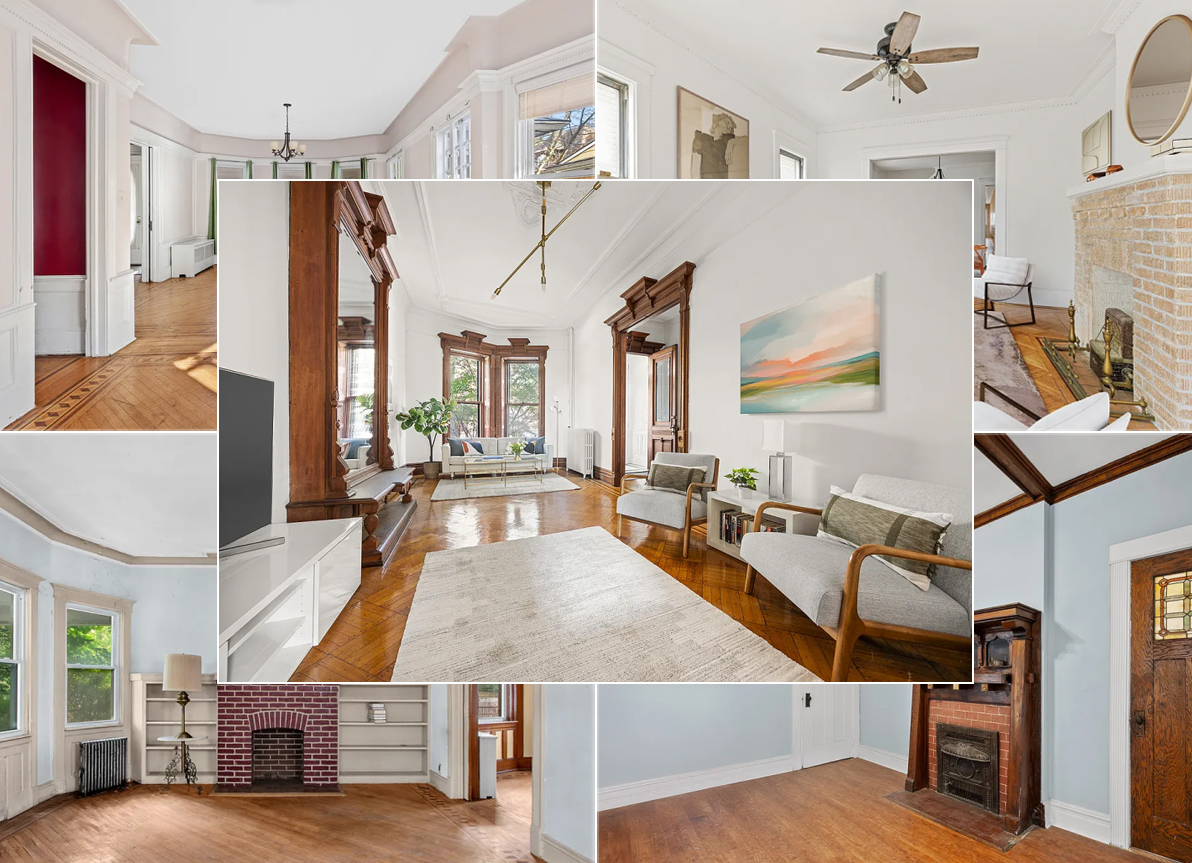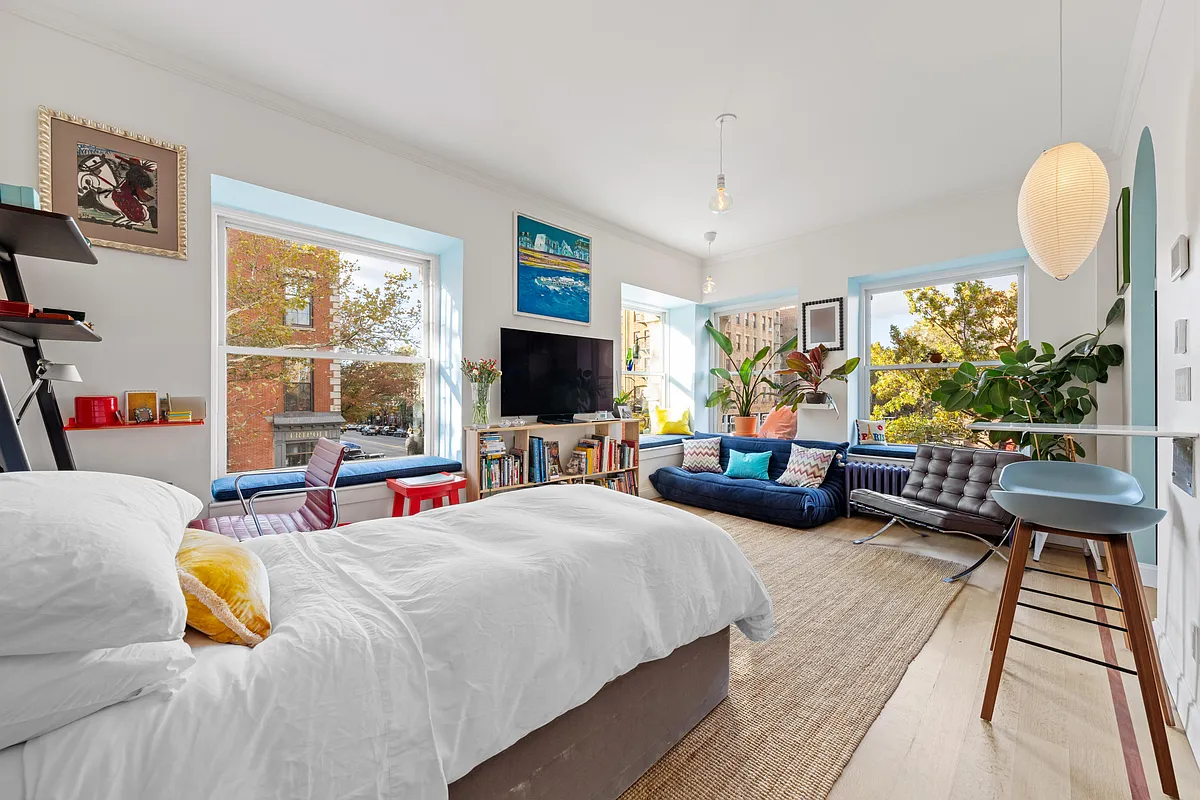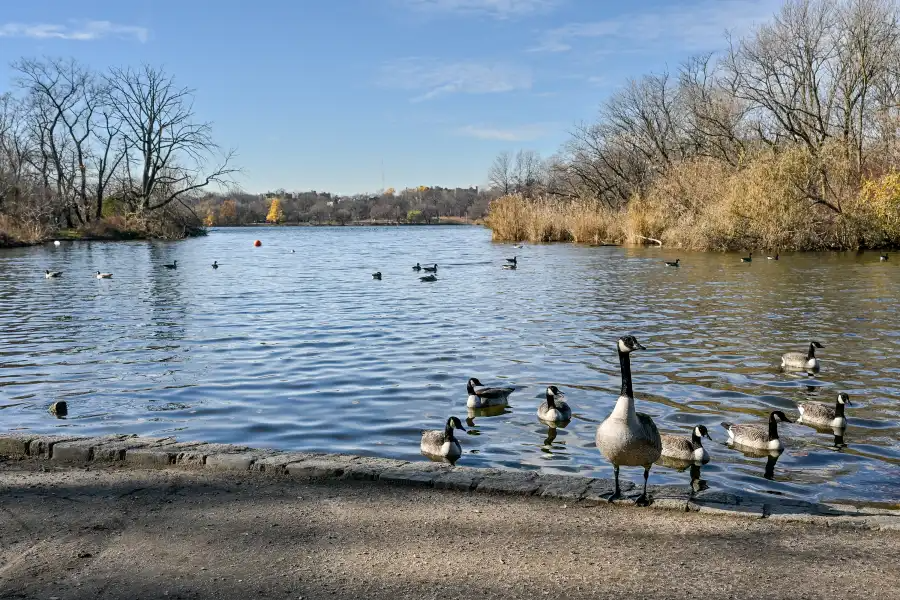The Real Deal: A Dose of Reality for Crown Heights Market
Citing some of the discussions on this blog, real estate mag The Real Deal puts the Crown Heights market in its place this month with an article entitled, “Sellers Swallowing Their Pride in Crown Heights.” While not dismissing the nabe’s merits, the basic thesis is that the market got ahead of itself and there’re are…


Citing some of the discussions on this blog, real estate mag The Real Deal puts the Crown Heights market in its place this month with an article entitled, “Sellers Swallowing Their Pride in Crown Heights.” While not dismissing the nabe’s merits, the basic thesis is that the market got ahead of itself and there’re are lots of homeowners with a deluded sense of what their places are worth. (Yesterday’s HOTD is further proof of that phenomenon.) Several brokers are surprisingly frank about clients who insisted on slapping ridiculous prices on their houses, only to have them languish on the market. Here’s a great anecdote:
Kevin McNeill, a senior vice president at Corcoran, is all too familiar with this phenomenon. He points to a three-story townhouse he helped put on the market for $1.2 million back in June. “It was overpriced, but her next-door neighbor had listed at $1.4 million,” says McNeill. “Hers was similar [to her neighbor’s], and when she saw $1.4 million it was hard to talk her off the ledge.” For two months the home languished. Then in August the seller agreed to drop the price by about $100,000, but still it sat. It wasn’t until McNeill convinced her to lower the price below $1 million that the house sold. “The minute we brought it to $995,000, we sold it within days,” says McNeill. “We closed at $960,000.”
The implicit conclusion of the article, which we’d agree with, seems to be that in the new, post-subprime paradigm, $1 million is a huge psychological barrier in Crown Heights, as it is for most of Bed Stuy. But as Corcoran’s McNeill says, “When people talk about price reductions in these neighborhoods, it’s not about the market, it’s about improper pricing.”
Sellers Swallowing Their Pride in Crown Heights [The Real Deal]
Photo by gkjarvis





Nostalgic on Park Avenue = Montrose Morris
People really. What kind of megalomania is it that motivates such absurdly long, verbose posts. What *content* is in these posts could be expressed easily in two short paragraphs, perhaps even one. You must really love listening to yourselves.
Brownstoner:
Before going to the body of this posting (triggered by the photo of the Carroll Street houses, looking just the way I remember them as a child), I’d like to share some information with people who are waiting for better stores and amenities in Crown Heights before buying in the area.
If you wait that long, you won’t be able to afford it.
A good friend with a PhD in planning taught me this: commercial streets in residential neighborhoods are the first to go during their areas’ decline, and the last to come back during their areas’ comeback. And she knew what she was talking about, having written her thesis on New York City planning and having served as a city official. My suggestion to those straddling the fence on Crown Heights: if you find an affordable house or apartment where you’d like to live (rather than just flip), buy and hold; join others in the neighborhood working to improve Nostrand Avenue (some of them blogging on this site); and remember: services were terrible on the Upper West Side, SoHo, TriBeCa, and — yes! — Park Slope before a density of residents with discretionary income changed the scene. (And, of course, it was the ones who bought before the curve who profited most handsomely down the road.)
Now about the photograph. In past postings I’ve described Crown Heights during the good times when I was a youngster. This pic reminds me of the neighborhood’s tougher days in the late 1950’s and early 1960’s. (Some bloggers think these great houses valueless now. Well, there was a time when you could barely give them away. And people are getting $750,000 to $900,000 today? I just hope they’re elders who got them cheap and can reap the benefits of “buy and hold”!)
Carroll Street was (and is) beautiful. I recall it being different from others in the neighborhood because it and some of the surrounding streets had alleys to garages out back. That makes me think these are newer brownstones than ones on streets like Dean, Sterling and Park and that they were built around World War I for people with cars.
I had friends in these houses and always enjoyed them. Although only two- or three-stories tall, their muscular “swell” fronts gave them a monumental character and created a distinctive, monolothic look to their blocks. As yet I hadn’t been to Europe, but I imagined this is what Europe looked like. The heavy, cast iron doors leading from their small ground-floor terraces (still visible in some of the houses in the pic), the interesting room shapes inside, and the views to trees along the street all spelled comfort to me — until the real estate speculators hit Crown Heights and many of my pals and their families moved out.
I’ll never forget it. I’m having a snack with a friend in his sunny ground-floor living room, sitting next to the bowfront windows and looking out on his great-looking street, when he announces that his family is moving to a “nice” neighborhood. (But wasn’t our neighborhood nice?) And I’d hear more and more about “nice” neighborhoods wherever I went. At my orthodontist’s tea parties for his patients’ parents, for example, held on the parlor floor of his limestone mansion (this wasn’t just a row house, but a full-fledged Belle-Epoque number), I listened to the other well-dressed white women speak to my mother about “the changes”; about the days when the neighborhood was “nice”; and how my orthodontist (who looked like George Brent in a 1930’s Warner Brothers flick and obviously enjoyed living well) was “still” the best, even though the neighborhood was “turning” (as if the neighborhood’s racial character had anything to with his skills — or prices; at $5,000 a pop he “still” cost a “bundle,” as my dad would say).
Then there was another friend on Carroll Street. She counted the number of her block’s recently-arrived African-American families on her fingers until she and her family disappeared, joining the flight to the suburbs. Down Crown Heights’ elegant blocks blew the real-estate flyers. Sell before losing your property’s value, they said. Let us who’ve helped your neighbors get out help you get out.
My family lived in an apartment. Pre-War. Six rooms. When my mother first saw it, she knew she had to have it, because the livingroom was big enough for the grand piano belonging to the elderly lady who’d just moved to a nursing home. We rented, so when the block busters arrived a few years later, their tactics were different from the ones applied to home owners. Suddenly, we regularly got letters from new owner- and management companies not listed in any phone book and impossible to contact. The building’s public spaces were degraded (the lobby’s furnishings chucked; incandescent lights replaced by flourescent; the faux-marble walls painted institutional green). The superintendent, who’d worked in the building for years and was as inobtrusive as he was capable, was replaced by a loud drunk. Individual apartments were turned into rooming houses. Then one night, a fire broke out, not electrical or accidental, but “suspicious.” (And from that night, I trembled in my bed at the first sound of fire trucks’ sirens — not a happy feeling for a nine-year old.)
There were people, my parents included, who bucked the trend. Organizing committees. Bringing lawsuits. Marching on St. Mark’s Avenue. But the speculation and block-busting proved unstoppable. Around the neighborhood, apartments and houses were cut up, a transient (often male) population was encouraged to move in, and bars started to appear on lots of street corners. I know now that much of this wouldn’t have happened without the collusion of banks (red-lining), the FHA (guaranteeing cheap mortgages only to outlying white neighborhoods and suburbs), developers like Levitt (who, until the 1960’s discriminated against people of color in his Levittowns — and said so in a two-page mea culpa in the New York Times after Martin Luther King’s assassination), and the planning commission (changing zoning to allow all those bars), but when you’re a kid you just hear the great sucking sound, pulling out your friends and social network and leaving behind a small, racially-integrated band of community activists who finally got exhausted and left. (It was the fire for my parents. How long can you stay in a place where your family isn’t safe?)
And as for “nice.” In our race-obssessed country, many of my white friends’ parents characteristically missfired. The early African-American owners were much classier than they, bringing along the Jack and Jill Club for their kids and cotillions at the Waldorf for their teenagers. And they had to have money, because banks wouldn’t give them mortgages and the FHA wouldn’t cover racially “mixed” neighborhoods. (Read John Oliver Killens, a friend of my parents who lived on Union Street, I think, for the low-down on Brooklyn’s African-American bourgeoisie of the period.)
So it’s bittersweet to see the houses on Carroll Street again. I’m happy to read in Brownstoner about neighbors who are rallying together to build on what’s still great in the neighborhood, but saddened that it’s taken this long for others to see what is intrinsically one of the best-built and most beautiful neighborhoods in the city. If my family had owned, I’m pretty sure they would have held. But as renters, they were overwhelmed.
Nostalgic on Park Avenue
First of all, let’s get this out of the way -I agree that the million dollar mark is both a realistic and psychological hurdle that this neighborhood is not ready to jump over, except in rare, one of a kind houses. I have never said otherwise, and as often as I praise and defend my neighborhood, I usually think the prices featured in most of the houses are too high.
It would be nice, for once, for someone who is writing these articles, to quote more people who are actually in the trenches, as it were, instead of always going to outside sources who look in, and act like experts. Contrary to their own popular belief, Corcoran, A&H, Halstead, etc, should never be the only real estate companies asked for their opinions on properties in neighborhoods like Crown Heights. In terms of the historical selling of real estate in this community, they showed up last week, and are in part, responsible for the huge hike in prices over the last few years – right when we got “discoveredâ€. These firms represent most of the better, and higher end properties in the area, including yesterday’s HOTD, the recent Park Place mansion, and the Pacific Street mansion of a couple of months back, mentioned by Jim Winters of Brooklyn Properties, who was the only broker who was actually gave a price range that corresponds to actual sales. These are all wonderful buildings, and fine examples of our architecture and our historical place as an upper class enclave, but not typical of the majority of homes in the area, and not typical of the prices of most of the homes for sale in the area.
I wish the Real Deal author had interviewed some smaller local brokers, like Denise Brown of DHB Properties, who was born and raised here, and sells a wide range of properties in the neighborhood, and could have given a better sense of the rest of the market. I also wish the author would do some research, and provided a better sense of history of the area. The Crown Heights Riots of ’91 were not the defining moment, and for the part of CH that the article is talking about – North Crown Heights, the riots were not here. They were in Crown Heights South, across Eastern Parkway, a very real divide in terms of racial and ethnic communities. To read the article is to think rioters were swarming the streets of Crown Heights North. That is simply not true.
The most telling part of the article was the fact that we are oversaturated with social service housing – the Armory is but one of the many, many facilities in our community. I agree with Rachel Pratt, who is one of the many activists working in our community. Her organization, along with the Crown Heights North Association, which spearheaded the landmarking initiatives, are all working to better this neighborhood for everyone here. The mixture of cultures, incomes, backgrounds and experiences here is unique, and we don’t want to lose that in a race to become the next upscale neighborhood. A vital commercial district will help unite our neighborhood, and that is something that will take much time, money and effort for a lot of reasons.
Crime and safety continue to be pressing issues, but contrary to popular belief, and the Brooklynian, the majority of people here, old and new, have not been the victims of crime, and do not feel unsafe. Who is going to risk life and limb in a war zone? It makes no sense. We stay here, and enjoy our homes because we do not feel unsafe. How many people, and how many times must it be said? Could it be better – of course. And let me say something about the postings on the Brooklynian. It is a message board, geared to and used by, a specific demographic – mostly white, twenty to thirty-somethings. They are not the entire community, or even a majority of the community. People post when something happens to them. They post when they find a new restaurant or bar, as often as they post when something bad happens to them. They are not going to post “I went out to work, and came back late, walking down Nostrand Avenue, and nothing happened to me.†Or “I went to the bodega on Franklin Avenue and bought a beer and chips, and came walked home, just like I do every night.†For every report of harassment or mugging, there are thousands upon thousands of days where nothing happens, therefore no posts.
We have a ways to go. I am not naïve or blind to the realities of where I live. I live here, walk down the streets, buy my groceries here, visit friends, do community work, and go to local restaurants and take out joints. My church is here, I bank blocks away in Bed Stuy, and I take the A train at Nostrand Avenue almost everyday. I walk in Brower Park, and know this neighborhood pretty well. If I was afraid, I would have left. If I thought it was going downhill, I could still get decent dollars for my house, and try somewhere else. But I believe in Crown Heights North. And there are a lot of us who feel the same way. Our goals are simple – slow, steady improvement through economic empowerment for all, community building through sensible real estate management, allowing a healthy mixture of affordable housing, middle income development and preservation, and use of our historic architectural heritage. Improvement of our commercial district, and programs and opportunities to bring those who have been left behind, educationally, economically, housing wise, into the prosperity that we see in our community’s future.
Crown Heights is not striving to be the new Park Slope – we already have one. We are striving to be our own unique selves – the best Crown Heights, an historic neighborhood with a rich and proud past, and a bright future.
Very long – sorry. I’m done now.
loooooooooovely.
Unfortunately, for me, Crown Heights is synonymous with “Let’s go to Kingston Avenue and get a Jew” and “riots”. Since this is all about “psychologically” breaking barriers, I can’t break that one, psychologically, especially for over a million dollars. Flame on.
Street looks clean and houses look clean.
where is crown heights?
is that near park slope?
Posted by: guest at December 6, 2007 4:51 PM
Less than 5 minutes away.
4:19, I don’t brag about the fact that she CAN do it because she DOESN’T do it. There’s a distinction there, Sweetheart. I hope you’ll at least attempt to master it.
Your mom, on the other hand, is probably working some Crown Heights alley as we speak, along with all of the other skanky ass, drug-addled whores that populate that nabe.